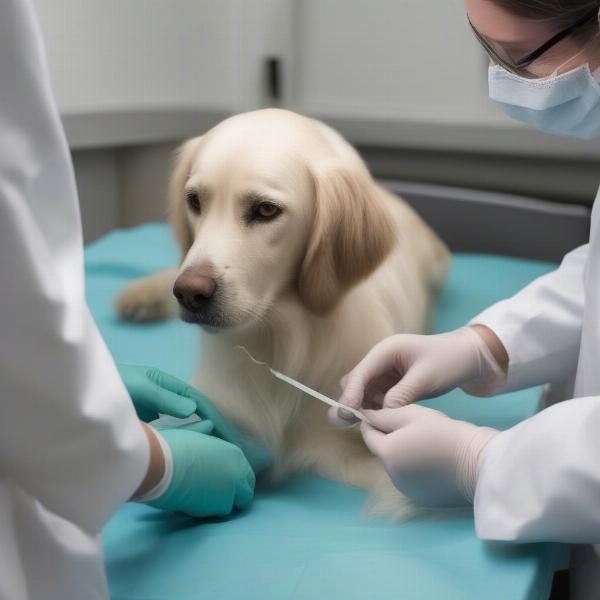Dog vaginal cytology is a valuable diagnostic tool used by veterinarians to assess a female dog’s reproductive status. This simple, yet powerful, procedure involves collecting cells from the vagina and examining them under a microscope. Understanding this procedure can help breeders time breeding, diagnose infections, and monitor overall reproductive health. Let’s dive into the specifics of canine vaginal cytology.
What is Dog Vaginal Cytology and Why is it Important?
Vaginal cytology provides crucial insights into the hormonal changes occurring within a female dog’s reproductive cycle. By observing the types and proportions of cells present in the vaginal smear, vets can determine the stage of the estrous cycle (heat). This information is particularly useful for breeders wanting to optimize the timing of mating for successful pregnancy. Beyond breeding, vaginal cytology can also identify infections and inflammation within the vagina, allowing for prompt treatment and preventing complications.
 Dog Vaginal Cytology Procedure
Dog Vaginal Cytology Procedure
The Different Stages of the Estrous Cycle as Reflected in Vaginal Cytology
The canine estrous cycle is divided into four main stages: proestrus, estrus, diestrus, and anestrus. Each stage presents unique cellular characteristics observable through vaginal cytology. During proestrus, red blood cells and large, round intermediate cells are prominent. As the cycle progresses to estrus, the optimal time for breeding, the red blood cells decrease, and cornified epithelial cells become dominant. These cornified cells appear angular and have a smaller nucleus. Diestrus is marked by a return of white blood cells and non-cornified epithelial cells. Finally, during anestrus, the resting phase, the vaginal smear primarily consists of parabasal cells, the smallest epithelial cell type.
How is Dog Vaginal Cytology Performed?
The procedure itself is relatively straightforward. A veterinarian gently inserts a sterile cotton swab into the vagina to collect a sample of cells. The swab is then rolled onto a glass slide, stained, and examined under a microscope. This quick and non-invasive procedure provides valuable information for managing a dog’s reproductive health.
Interpreting the Results of a Dog Vaginal Cytology
Interpreting the results of canine vaginal cytology requires expertise. While breeders can learn to perform basic cytology, consulting with a veterinarian is crucial for accurate diagnosis and breeding management. The proportions of different cell types, the presence of bacteria or inflammatory cells, and other characteristics observed under the microscope are all considered when determining the stage of the cycle or the presence of any abnormalities.
Conclusion
Dog vaginal cytology is a powerful tool for assessing a female dog’s reproductive health. By understanding the principles and interpretations of this procedure, breeders and owners can make informed decisions about breeding, diagnose potential infections, and ensure the overall well-being of their canine companions. Consulting with a veterinarian is essential for accurate interpretation and guidance based on the individual dog’s needs.
FAQs
- Is dog vaginal cytology painful? The procedure is generally quick and non-invasive, causing minimal discomfort.
- How often should vaginal cytology be performed? The frequency depends on the specific situation, such as breeding timing or diagnosing a suspected infection. Your vet can recommend the appropriate schedule.
- Can I perform vaginal cytology myself at home? While basic cytology can be learned, consulting with a veterinarian is crucial for accurate interpretation and diagnosis.
- What can vaginal cytology tell me about my dog’s health? It can determine the stage of the estrous cycle, identify infections or inflammation, and provide insights into overall reproductive health.
- What if the cytology results are abnormal? Your veterinarian will discuss the findings and recommend appropriate treatment or further diagnostic testing.
- How much does dog vaginal cytology cost? The cost varies depending on the veterinary clinic and any additional testing required.
- Are there any risks associated with dog vaginal cytology? Risks are minimal, primarily limited to slight discomfort during sample collection.
Related Articles:
About ILM Dog:
ILM Dog is your trusted source for comprehensive information on dog care, breeding, and health. We offer expert advice and resources to help dog owners and breeders make informed decisions about their canine companions. From breed selection and training to health and nutrition, ILM Dog is dedicated to providing valuable insights and support. Contact us for more information: Email: [email protected], Phone: +44 20-3965-8624.